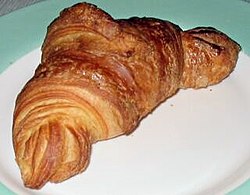Croissant
- For the Japanese women's magazine, see Croissant (magazine).

A croissant (IPA: [kʁwa'sɑ̃] , anglicised variously as IPA /krə'sant/, /kwa'son/, etc.) is a buttery flaky pastry, named for its distinctive crescent shape.
Crescent-shaped breads have been made since the Middle Ages.[citation needed]
Croissants are made of a leavened variant of puff pastry by layering yeast dough with butter and rolling and folding a few times in succession, then rolling. Making croissants by hand requires skill and patience; a batch of croissants can take several days to complete. However, the development of factory-made, frozen, pre-formed but unbaked dough has made them into a fast food which can be freshly baked by unskilled labor. Indeed, the croissanterie was explicitly a French response to American fast food. This innovation, along with the croissant's versatility and distinctive shape, has made it the best-known type of French pastry in much of the world. In many parts of the United States, for example, the croissant (introduced at the fast food chains Arby's in the United States and Tim Hortons in Canada in 1983) has come to rival the long-time favorite doughnuts[citation needed].
Origin

Fanciful stories of how the bread was created are modern culinary legends. These include tales that it was invented in Poland to celebrate the defeat of a Muslim invasion at the decisive Battle of Tours by the Franks in 732, with the shape representing the Islamic crescent; that it was invented in Vienna in 1683 to celebrate the defeat of the Turkish siege of the city, as a reference to the crescents on the Turkish flags, when bakers staying up all night heard the tunneling operation and gave the alarm; a version that is supported by the fact that croissants in French Language are referred to as Viennoiserie (a Romanian version called "cornulet" (meaning "little crescent") is partially referenced in the movie The Terminal) and croissant is the French word for crescent; tales linking croissants with the kifli and the siege of Buda in 1686; and those detailing Marie Antoinette's hankering after a Viennese specialty. Alan Davidson, editor of the Oxford Companion to Food states that no printed recipe for the present-day croissant appears in any French recipe book before the early 20th century; the earliest French reference to a croissant he found was among the "fantasy or luxury breads" in Payen's Des substances alimentaires, 1853.
The "Siege of Vienna" story seems to owe its wide diffusion to Alfred Gottschalk, who wrote about the croissant for the first edition of the Larousse Gastronomique (1938). Gottschalk first cited the legend about the Turkish attack on Budapest in 1686, in the "history of food" section in the same work, he opted for the "siege of Vienna in 1683" version.
Variants
Croissant pastry can also be wrapped around almond paste or chocolate before it is baked (in the latter case, it becomes like pain au chocolat, which has a different, non-crescent, shape), or sliced to admit sweet or savoury fillings. In France, croissants are generally sold without filling and eaten without added butter, but sometimes with almond filling. In the United States, sweet fillings or toppings are common, and warm croissants may be filled with ham and cheese or feta cheese and spinach. In the Levant, croissants are sold plain or filled with chocolate, cheese, almonds, or zaatar.
